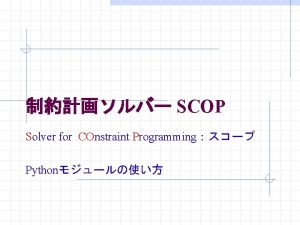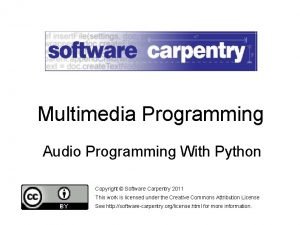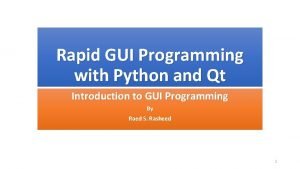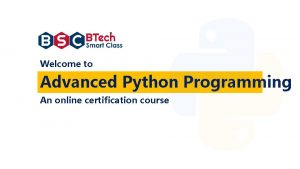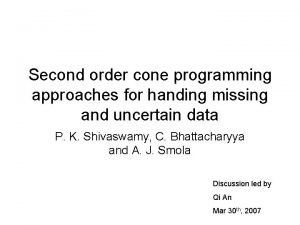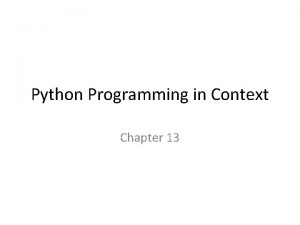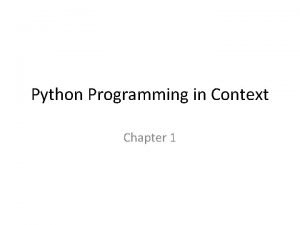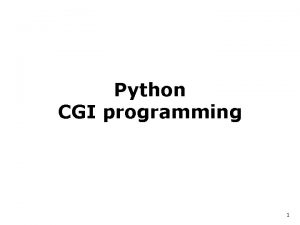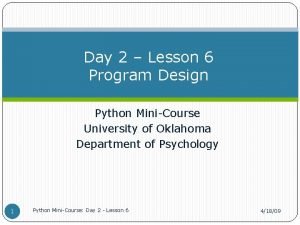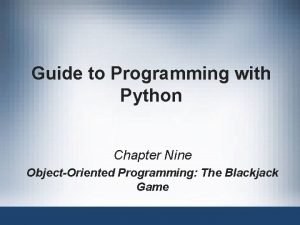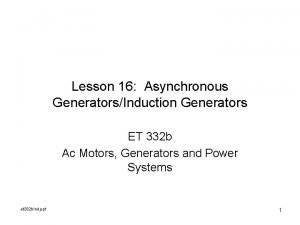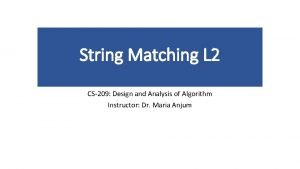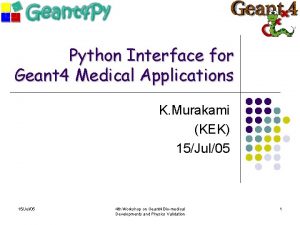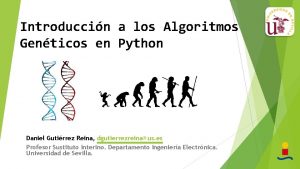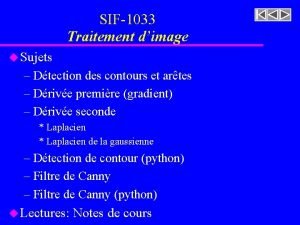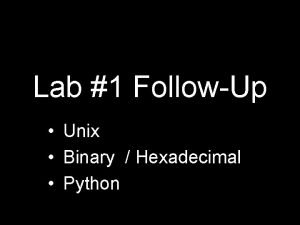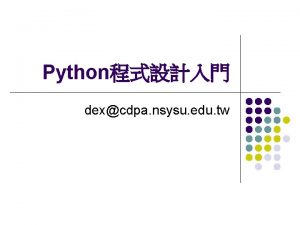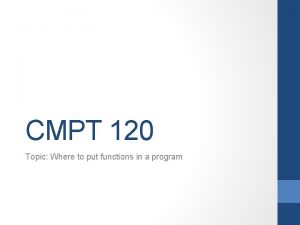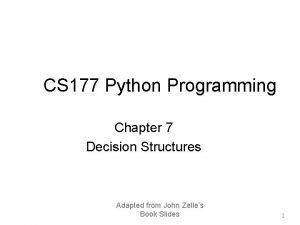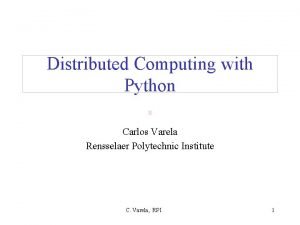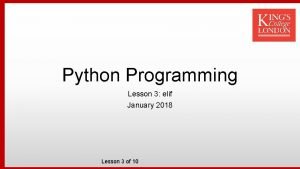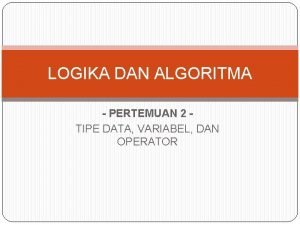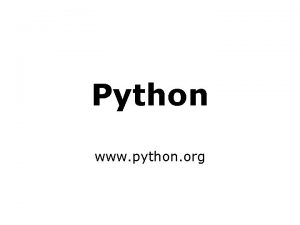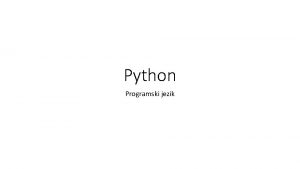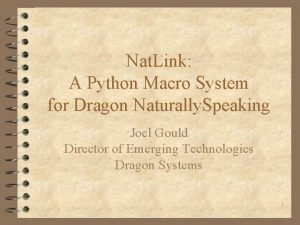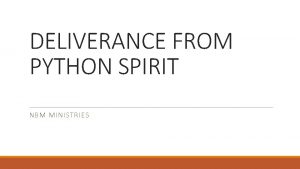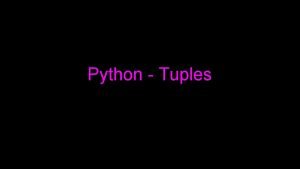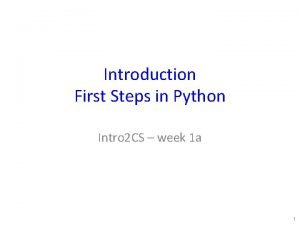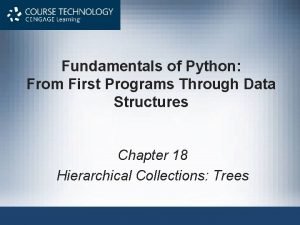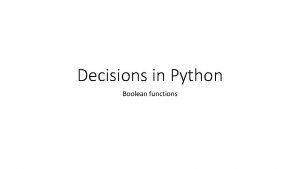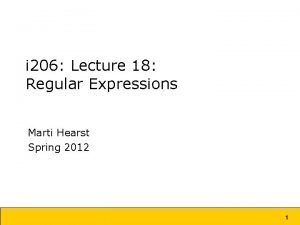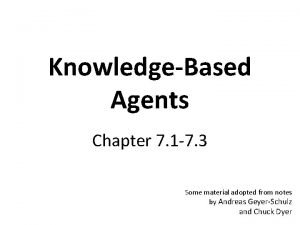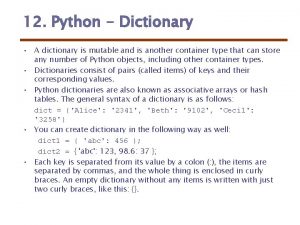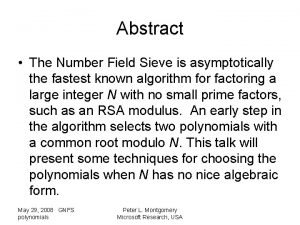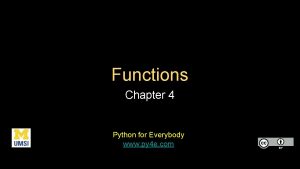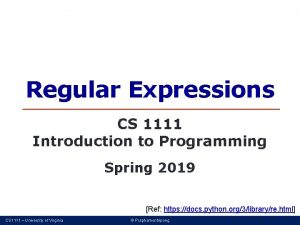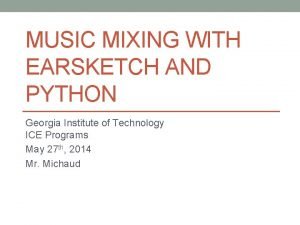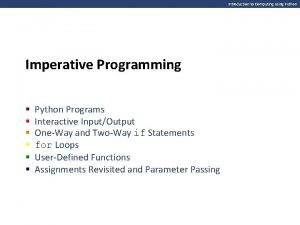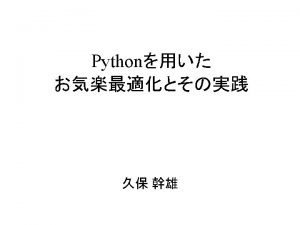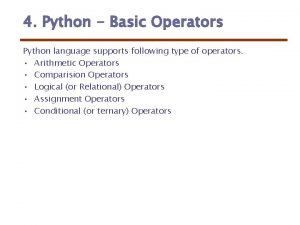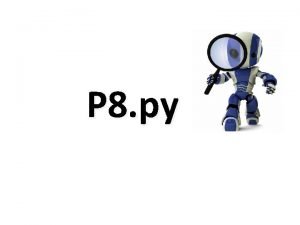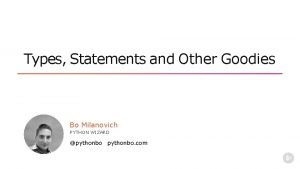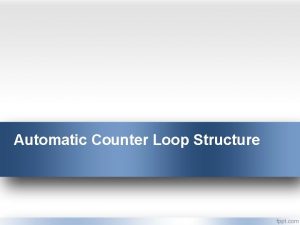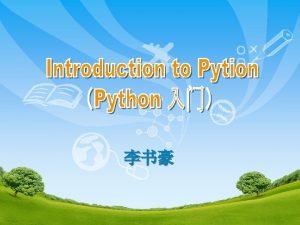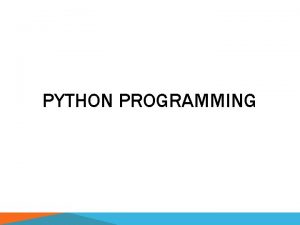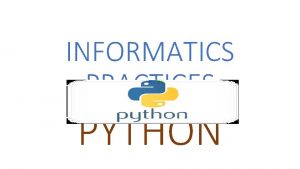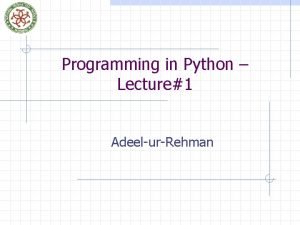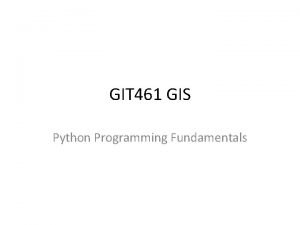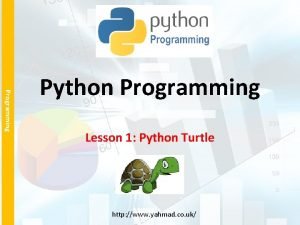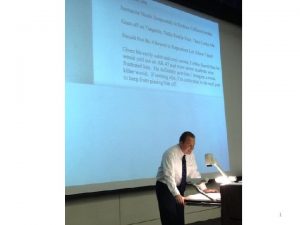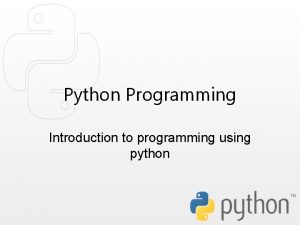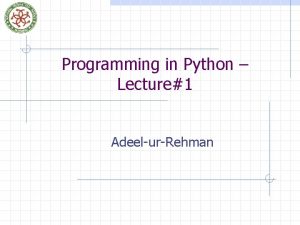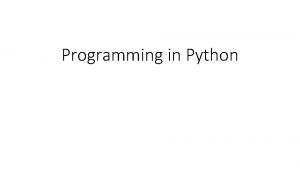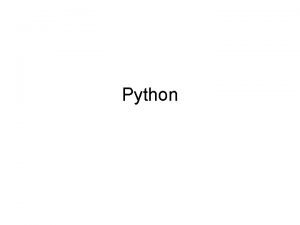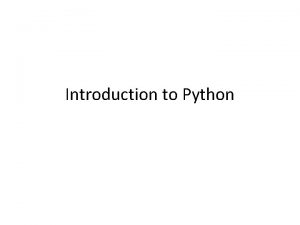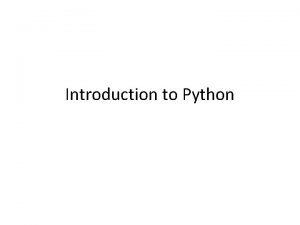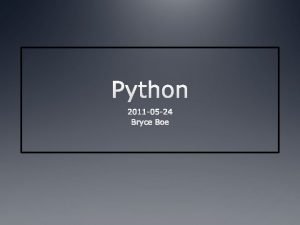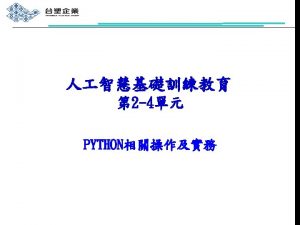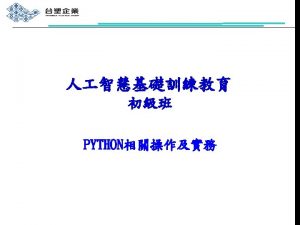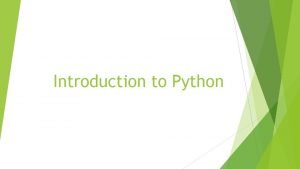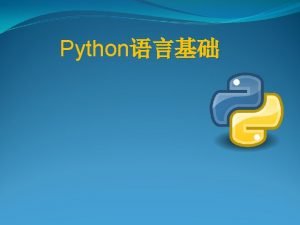Python Programming 2e 3 Python Programming 2e 4






























































- Slides: 62


每題答錯的人數 Python Programming, 2/e 3

成績分布 Python Programming, 2/e 4

Python Programming: An Introduction to Computer Science Chapter 6 Defining Functions Python Programming, 2/e 5

Objectives n n n To understand why programmers divide programs up into sets of cooperating functions. To be able to define new functions in Python. To understand the details of function calls and parameter passing in Python Programming, 2/e 6

Objectives (cont. ) n To write programs that use functions to reduce code duplication and increase program modularity. Python Programming, 2/e 7

The Function of Functions n So far, we’ve seen four different types of functions: n n Our programs comprise a single function called main(). Built-in Python functions (abs()) Functions from the standard libraries (math. sqrt()) Functions from the graphics module (p. get. X()) Python Programming, 2/e 8

Why We Need Functions? n Having similar or identical code in more than one place has some drawbacks. 1. 2. n Writing the same code twice or more. This same code must be maintained in two separate places. Functions can be used to reduce code duplication and make programs more easily understood and maintained. Python Programming, 2/e 9

Functions, Informally n n A function is like a subprogram, a small program inside of a program. The basic idea – we write a sequence of statements and then give that sequence a name. We can then execute this sequence at any time by referring to the name. Python Programming, 2/e 10


Functions, Informally n n The part of the program that creates a function is called a function definition. When the function is used in a program, we say the definition is called or invoked. Python Programming, 2/e 12

Example of Statement Duplication n Happy Birthday lyrics… def main(): print("Happy n birthday to you!" ) birthday, dear Fred. . . ") birthday to you!") Gives us this… >>> main() Happy birthday to you! Happy birthday, dear Fred. . . Happy birthday to you! Python Programming, 2/e 13

Functions, Informally n n There’s some duplicated code in the program! (print("Happy birthday to you!")) We can define a function to print out this line: def happy(): print("Happy birthday to you!") n Function definition With this function, we can rewrite our program. Python Programming, 2/e 14

Functions, Informally n The new program – def sing. Fred(): happy() Invoke the happy() print("Happy birthday, dear Fred. . . ") happy() n function Gives us this output – >>> sing. Fred() Happy birthday to you! Happy birthday, dear Fred. . . Happy birthday to you! Python Programming, 2/e 15

Functions, Informally n n Creating this function saved us a lot of typing! What if it’s Lucy’s birthday? We could write a new sing. Lucy function! def sing. Lucy(): happy() print("Happy birthday, dear Lucy. . . ") happy() Python Programming, 2/e 16

Functions, Informally n We could write a main program to sing to both Lucy and Fred def main(): sing. Fred() print() sing. Lucy() n This gives us this new output >>> main() Happy birthday to you! Happy birthday, dear Fred. . Happy birthday to you! Happy birthday to you! birthday, dear Lucy. . . birthday to you! Python Programming, 2/e 17

Functions, Informally n n n This is working great! But… there’s still a lot of code duplication. The only difference between sing. Fred and sing. Lucy is the name in the third print statement. These two routines could be collapsed together by using a parameter. Python Programming, 2/e 18

Functions, Informally n The generic function sing def sing(person): happy() print("Happy birthday, dear", person + ". “) happy() n This function uses a parameter named person. A paramater is a variable that is initialized when the function is called. Python Programming, 2/e 19

Functions, Informally n Our new output – >>> sing("Fred") Happy birthday to you! Happy birthday, dear Fred. Happy birthday to you! n We can put together a new main program! Python Programming, 2/e 20

Functions, Informally n Our new main program: def main(): sing("Fred") print() sing("Lucy") n Gives us this output: >>> main() Happy birthday to you! Happy birthday, dear Fred. Happy birthday to you! Happy birthday to you! birthday, dear Lucy. birthday to you! Python Programming, 2/e 21

Exercise: London Bridge n Develop a program with functions to print the following lyrics: n n n n London Bridge is falling down, London Bridge is falling down, My fair lady. Revise your program so that “Macau Bridge” will be falling down after “London Bridge”. Compare your code with the one of your classmate. See who can get this task done with a fewer lines of program. Python Programming, 2/e 22

Functions and Parameters: The Details n A function definition looks like this: def <name>(<formal-parameters>): <body> n n The name of the function must be an identifier Formal-parameters is a possibly empty list of variable names Python Programming, 2/e 29

Functions and Parameters: The Details n Formal parameters, like all variables used in the function, are only accessible in the body of the function. Variables with identical names elsewhere in the program are distinct from the formal parameters and variables inside of the function body. Python Programming, 2/e 30

Functions and Parameters: The Details n n A function is called by using its name followed by a list of actual parameters or arguments. <name>(<actual-parameters>) When Python comes to a function call, it initiates a four-step process. (P. 176) Python Programming, 2/e 31

Functions and Parameters: The Details (P. 176) 1. 2. 3. 4. The calling program suspends execution at the point of the call. The formal parameters of the function get assigned the values supplied by the actual parameters in the call. The body of the function is executed. Control returns to the point just after where the function was called. Python Programming, 2/e 32

Functions and Parameters: The Details n Let’s trace through the following code: sing("Fred") print() sing("Lucy") n n When Python gets to sing("Fred"), execution of main is temporarily suspended. Python looks up the definition of sing and sees that it has one formal parameter, person. (See P. 172) Python Programming, 2/e 33

Functions and Parameters: The Details n The formal parameter is assigned the value of the actual parameter. It’s as if the following statement had been executed: person = "Fred" Python Programming, 2/e 34

Figure 6. 1: Control Transferring to sing() (P. 177) def sing(person): happy() person = "Fred" happy() print("Happy birthday, dear", person + def main(): ". ") sing("Fred") happy() print() sing("Lucy") person : "Fred" Note that the variable person has just been initialized. Python Programming, 2/e 35

Functions and Parameters: The Details n n At this point, Python begins executing the body of sing. The first statement is another function call, to happy. What happens next? Python suspends the execution of sing and transfers control to happy consists of a single print(), which is executed and control returns to where it left off in sing(). Python Programming, 2/e 36

Figure 6. 2: Snapshot of completed call to happy()P. 177 n n Execution continues in this way with two more trips to happy. When Python gets to the end of sing, control returns to main and continues immediately following the function call. Python Programming, 2/e 37

Figure 6. 3: Snapshot of completed call to sing() (P. 178) n n n Notice that the person variable in sing has disappeared! The memory occupied by local function variables is reclaimed when the function exits. Local variables do not retain any values from one function execution to the next. Python Programming, 2/e 38

Functions and Parameters: The Details n n The next statement is the bare print(), which produces a blank line. Python encounters another call to sing(), and control transfers to the sing() function, with the actual parameter “Lucy”. Python Programming, 2/e 39

Functions and Parameters: The Details (Fig. 6. 4 P. 178) n The body of sing is executed for Lucy with its three side trips to happy and control returns to main. Python Programming, 2/e 40

Functions and Parameters: The Details (Fig. 6. 5, P. 179) Python Programming, 2/e 41

Getting Results from a Function n Passing parameters provides a mechanism for initializing the variables in a function. Parameters act as inputs to a function. We can call a function many times and get different results by changing its parameters. Python Programming, 2/e 45

Functions That Return Values n We’ve already seen numerous examples of functions that return values to the caller. disc. Rt = math. sqrt(b*b – 4*a*c) n n The value b*b – 4*a*c is the actual parameter of math. sqrt(). We say sqrt returns the square root of its argument. Python Programming, 2/e 46

Functions That Return Values n This function returns the square of a number: def square(x): return x*x n n When Python encounters return, it exits the function and returns control to the point where the function was called. In addition, the value(s) provided in the return statement are sent back to the caller as an expression result. Python Programming, 2/e 47

Functions That Return Values n n >>> 9 >>> 16 >>> >>> 25 >>> 34 square(3) print(square(4)) x = 5 y = square(x) print(y) print(square(x) + square(3)) Python Programming, 2/e 48

Functions That Return Values n n We can use the square function to write a routine to calculate the distance between (x 1, y 1) and (x 2, y 2). def distance(p 1, p 2): dist = math. sqrt(square(p 2. get. X() - p 1. get. X()) + square(p 2. get. Y() - p 1. get. Y())) return dist Python Programming, 2/e 49

Functions That Return Values n n n Sometimes a function needs to return more than one value. To do this, simply list more than one expression in the return statement. def sum. Diff(x, y): sum = x + y diff = x – y return sum, diff Recall the “Simultaneous Assignment” on P. 40 Python Programming, 2/e 50

Functions That Return Values n n n When calling this function, use simultaneous assignment (P. 40). num 1, num 2 = eval(input("Enter two numbers (num 1, num 2) ")) s, d = sum. Diff(num 1, num 2) print("The sum is", s, "and the difference is", d) As before, the values are assigned based on position, so s gets the first value returned (the sum), and d gets the second (the difference). Python Programming, 2/e 51

Functions That Return Values n If your value-returning functions produce strange messages, check to make sure you remembered to include the return! def star(n): print( '*' * n ) ***** None print( star(10) ) Python Programming, 2/e 53

Functions That Return Values def star(n): print( '*' * n ) ***** None print( star(10) ) def star(n): return '*' * n ***** print( star(10) ) print( star(5) + star(5) ) Python Programming, 2/e 54

Exercise: Cubic Root n Design a function cubrt(n) to return the cubic root of n. n Test your function with the following main program def main(): a = eval(input("Please input a number - ")) print("The cubic root of", a, "is", cubrt(a) ) main() Python Programming, 2/e 55

Functions that Modify Parameters n n n Return values are the main way to send information from a function back to the caller. Sometimes, we can communicate back to the caller by making changes to the function parameters. Understanding when and how this is possible requires the mastery of some subtle details about how assignment works and the relationship between actual and formal parameters. Python Programming, 2/e 56

Functions that Modify Parameters n n Suppose you are writing a program that manages bank accounts. One function we would need to do is to accumulate interest on the account. Let’s look at a first attempt at the function. def add. Interest(balance, rate): new. Balance = balance * (1 + rate) balance = new. Balance Python Programming, 2/e 57

Functions that Modify Parameters n n The intent is to set the balance of the account to a new value that includes the interest amount. Let’s write a main program to test this: def test(): amount = 1000 rate = 0. 05 add. Interest(amount, rate) print(amount) Python Programming, 2/e 58

Functions that Modify Parameters n The first two lines of the test() function create two local variables called amount and rate which are given the initial values of 1000 and 0. 05, respectively. def add. Interest(balance, rate): new. Balance = balance * (1 + rate) balance = new. Balance def test(): amount = 1000 rate = 0. 05 add. Interest(amount, rate) print(amount) Is the result of test() 1050 or 1000? Python Programming, 2/e 60

Functions that Modify Parameters n n n Control then transfers to the add. Interest function. The formal parameters balance and rate are assigned the values of the actual parameters amount and rate. Even though rate appears in both, they are separate variables (because of scope rules). def add. Interest(balance, rate): new. Balance = balance * (1 + rate) balance = new. Balance def test(): amount = 1000 rate = 0. 05 add. Interest(amount, rate) print(amount) Python Programming, 2/e 61

Figure 6. 6: Transfer of control to add. Interest() (P. 185) Python Programming, 2/e 63

Functions that Modify Parameters n n Executing the first line of add. Interest creates a new variable, new. Balance. balance is then assigned the value of new. Balance. def add. Interest(balance, rate): new. Balance = balance * (1 + rate) balance = new. Balance def test(): amount = 1000 rate = 0. 05 add. Interest(amount, rate) print(amount) Python Programming, 2/e 64

Figure 6. 7: Assignment of balance Python Programming, 2/e 66

Functions that Modify Parameters n n Execution of add. Interest has completed and control returns to test. The local variables, including the parameters, in add. Interest go away, but amount and rate in the test function still refer to their initial values! def add. Interest(balance, rate): new. Balance = balance * (1 + rate) balance = new. Balance def test(): amount = 1000 rate = 0. 05 add. Interest(amount, rate) print(amount) Python Programming, 2/e 67

Pass by Value in Python n n To summarize: the formal parameters of a function only receive the values of the actual parameters. The function does not have access to the variable that holds the actual parameter. Python is said to pass all parameters by value. Python Programming, 2/e 68

Pass by Reference in C++ n Some programming languages (C++, Ada, and many more) do allow variables themselves to be sent as parameters to a function. This mechanism is said to pass parameters by reference. n In that case, when a new value is assigned to the formal parameter, the value of the variable in the calling program actually changes. Python Programming, 2/e 69

Values Sent Back by return def add. Interest(balance, rate): new. Balance = balance * (1 + rate) return new. Balance def test(): amount = 1000 rate = 0. 05 amount = add. Interest(amount, rate) print(amount) test() Python Programming, 2/e 71

Functions that Modify Parameters n n Instead of looking at a single account, say we are writing a program for a bank that deals with many accounts. We could store the account balances in a list, then add the accrued interest to each of the balances in the list. We could update the first balance in the list with code like: balances[0] = balances[0] * (1 + rate) Python Programming, 2/e 72

Functions that Modify Parameters # addinterest 3. py # Illustrates modification of a mutable parameter (a list). def add. Interest(balances, rate): for i in range(len(balances)): balances[i] = balances[i] * (1+rate) def test(): amounts = [1000, 2200, 800, 360] rate = 0. 05 add. Interest(amounts, 0. 05) print(amounts) test() Python Programming, 2/e 74

Functions that Modify Parameters n Remember, our original code had these values: [1000, 2200, 800, 360] n The program returns: [1050. 0, 2310. 0, 840. 0, 378. 0] n What happened? Python passes parameters by value, but it looks like amounts has been changed! Python Programming, 2/e 75

Functions and Program Structure n n n So far, functions have been used as a mechanism for reducing code duplication. Another reason to use functions is to make your programs more modular. As the algorithms you design get increasingly complex, it gets more and more difficult to make sense out of the programs. Python Programming, 2/e 84

Functions and Program Structure n n One way to deal with this complexity is to break an algorithm down into smaller subprograms, each of which makes sense on its own. This topic will be discussed in more detail in Chapter 9. Python Programming, 2/e 85

Exercise P. 198 Ex. 12 n n n Write a function sum. List(nums), where nums is a list of numbers. Return the sum of the numbers in the list. Test it with the following code: def main(): print( sum. List([1, 2, 3, 4]) ) print( sum. List( range(101) ) ) main() Python Programming, 2/e 89
 Constraint programming python
Constraint programming python Pygaxy
Pygaxy Python chapter 5 programming exercises
Python chapter 5 programming exercises Python programming an introduction to computer science
Python programming an introduction to computer science Rapid gui programming with python and qt
Rapid gui programming with python and qt String python
String python Second order cone programming python
Second order cone programming python Python programming in context
Python programming in context Programming essentials in python
Programming essentials in python Python programming in context
Python programming in context Python cgi form example
Python cgi form example Python procedural programming
Python procedural programming Python blackjack oop
Python blackjack oop Linear vs integer programming
Linear vs integer programming Definisi integer
Definisi integer Perbedaan linear programming dan integer programming
Perbedaan linear programming dan integer programming Definition of system programming
Definition of system programming Greedy algorithm vs dynamic programming
Greedy algorithm vs dynamic programming Induction generator ppt
Induction generator ppt Hitran python
Hitran python Caffe deep learning tutorial
Caffe deep learning tutorial Rabin karp python
Rabin karp python Python geant4
Python geant4 Algoritmos genéticos ejemplos resueltos python
Algoritmos genéticos ejemplos resueltos python Canvas elte login
Canvas elte login Filtre de canny python
Filtre de canny python Hexadecimal to binary python
Hexadecimal to binary python Python
Python Top down design coding
Top down design coding Comment python block
Comment python block Cx_oracle.sessionpool
Cx_oracle.sessionpool Decision structures in python
Decision structures in python Python remote objects
Python remote objects Primm python
Primm python Import tkinter as tk
Import tkinter as tk Data type logical
Data type logical Python org
Python org Kristina ledinski
Kristina ledinski Djelomični količnik
Djelomični količnik Python mouse macro
Python mouse macro Prayers that paralyze the python spirit
Prayers that paralyze the python spirit Python sort list of tuples
Python sort list of tuples Python basic topics
Python basic topics Fundamentals of python data structures
Fundamentals of python data structures Branching python
Branching python Python supply chain optimization
Python supply chain optimization 792015
792015 Python boolean
Python boolean Hearst patterns python
Hearst patterns python Knowledge based agent
Knowledge based agent Meaning of mutable in python
Meaning of mutable in python General number field sieve python
General number field sieve python Tarkustech
Tarkustech Fruitful and non fruitful function in python
Fruitful and non fruitful function in python Re.finditer in python
Re.finditer in python Earsketch
Earsketch Python imperative
Python imperative Mip python
Mip python Python unary
Python unary 8 puzzle a* python
8 puzzle a* python Python bo
Python bo Microsoft virtual academy
Microsoft virtual academy Iterate counter python
Iterate counter python
